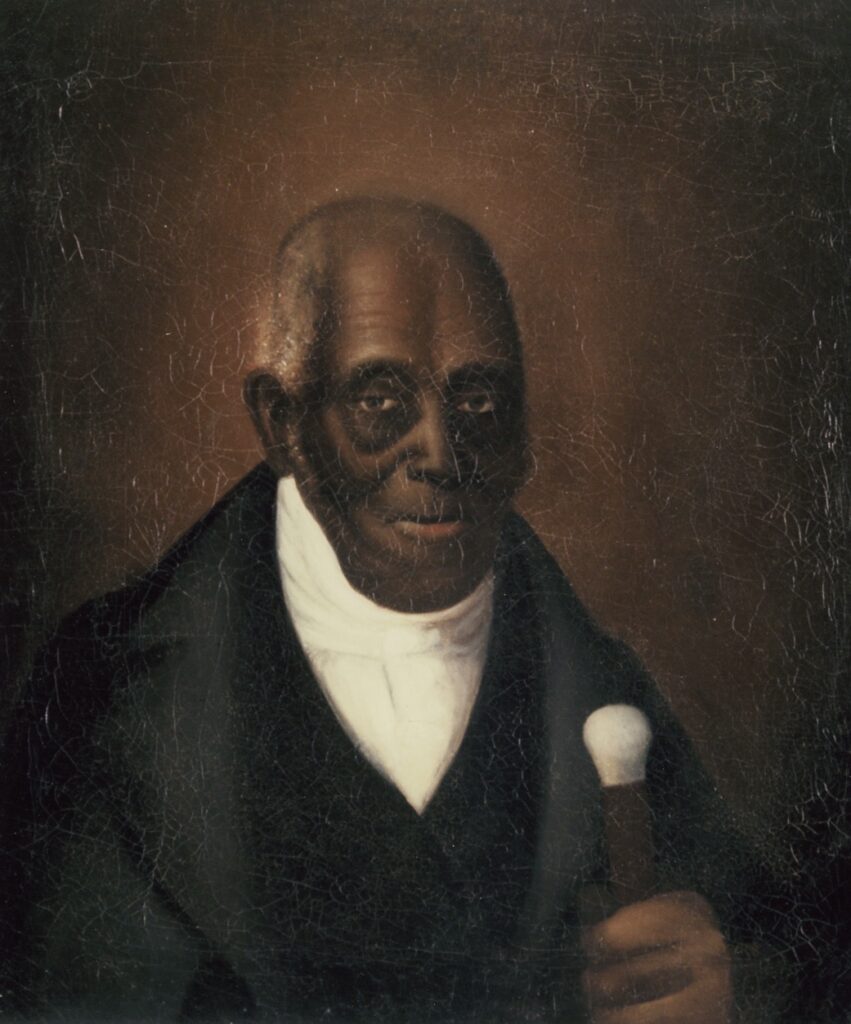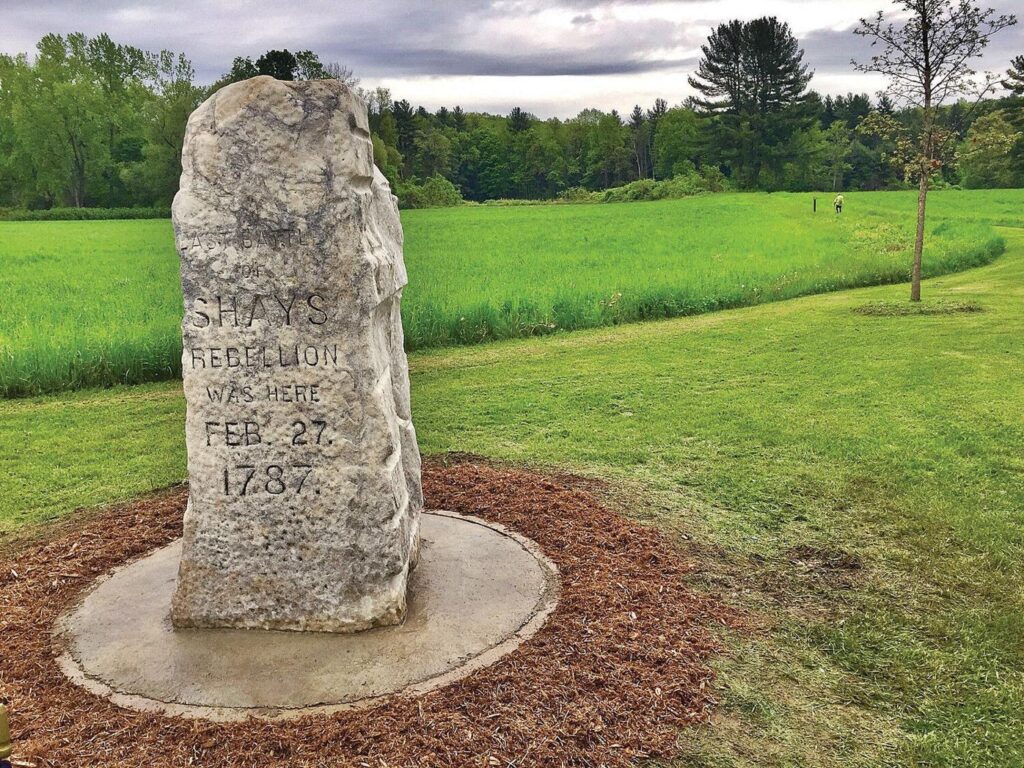Welcome to Bidwell Lore number 145! This week we will share a story about Shays’ Rebellion and Agrippa’s experience during that time.

Agrippa Hull and Shays Rebellion
Rick Wilcox, 2022
In this installment of Agrippa’s story, we are going to look at Shays’ Rebellion and begin with a detailed account from a letter written by Dr. Erastus Sargeant to Major John Sheppard.
Dr. Erastus Sergeant [1] to Major Sheppard March 5, 1787
Stockbridge March 5 1787
Dear Sir,
When you was here, I had
the most sanguine prospects of making
you a payment before this time,
but we have nothing but a scene
of war & distress since the beginning
of Feb 7 which has prevented
my collecting any money worth
your receiving, you may depend
on my exertions in your favor
as soon as there is the lest prospect
of success – I am On Tuesday morning
the 7 ulto about daybreak I had my House surrounded by twelve
Armed Men with a Demand of
entrance & surrender to Shays
with the most horrid imprecations
and diabolical refuges that is possible to possess The human appearance
before we could have time to determine
weather it would be best to give them
[page 2]
enterance, they drew their bayonets
thro’ the Windows ^of my lodging Room by repeated thrusts
broke the sash and
6 or 8 lights of Glass [illegible] in the room. I, my Wife & small
children lodged then, run with the same
degree of violence bust an out side
door and an entery door which led
into the same room, pointed the
bayonets to my Wives breast, with
a demand of Arms & ammunition
at the same time they had found
an enterance to almost every Room
of my House. After getting what Arms
& Ammunition they could find, and
what plunder they pleased, which
consisted of cloathing, silver Buckles
some cash Hast that so they ordered
us to prepare to march immediately to
head quarters, which was then at
Mrs,. Bingham, [2] where I found almost all
my Neighbors in the same unhappy
[page 3]
Situation, the commanding officer, Capt.
Hamlin, informed me, I must go with him
and gave me permission to return home and
take an horse or sleigh & what other
comforts I pleased, which I considered as
a very great indulgence, they plundered
6 homes and mounted them as Bidets and
marched out of Town just about two
hours high in the morning with 32 prisoners, we went
to Barrington they there joined
by a number more, our Friends at Bar
rington got information timely to make
their escape to Sheffield, where with an
uncommon order and spirit they collected
a force sufficient to attack them, which
they did on the road from Barrington to
Sheffield, tho, they decoyed ^them out of the com
mon road there strength was nearly equal
the prisoners where pushed on at the point
of the bayonet to the Scene of Action
a cruelty unknown in the most barbarous
[page 4]
Nation, but kind province
so ordered it that but one of the
poor prisoners fell, whether by
the fire of our people or the Rebels
is uncertain, the attack was valiant
& resolute on both sides, Hamlin
received a mortal Wound, which
disconcerted his Men & they fled
with precipitation into every
direction, leaving one dead & two
Mortally Wounded, by the seasonable
reinforcements under Genl McMerran [3]
in their rear, about fifty of there Number
were made prisoners, we lost two
killed [4] and one wounded but I hope
not mortal, thus ended this rash
incursion of the Rebels which they
plumbed themselves much on – I have
spun out this a much greater length
then I intended. Am your Friend
& Servt .
Erastus Sergeant
Maj: Sheppard [5]

As noted in the letter, before departing Stockbridge, the Shayites gathered their hostages at Widow Bingham’s tavern. Among a number of other prisoners, in addition to Dr. Erastus Sergeant, they took his brother-in-law Dr. Oliver Partridge from his Prospect Hill home.
“It was not long before a band of rebels had collected at West Stockbridge under the command of Hubbard, amounting to between 150 and 200 men, and the number was continually increasing. The only way to prevent bloodshed was to disperse them as early as possible. The army at Stockbridge was duly authorized to act independently, government having requested the citizens to defend themselves as far as it could be done, without calling on the public force. Accordingly, the whole body was formed into three divisions, and while the central took the direct route through Larawaugh, [6] and over the mountain, to the village, a second, under Capt. Goodrich, to the southern, and third, under Major Rowley of Richmond, took a northern route. As an advance party of the central division, consisting of 27 infantry, and 7 cavalry, approaching the insurgents, they were fired upon by the sentries, and the whole rebel force was at once formed in order of battle, and commanded to fire. But before this little band of their fellow citizens, they faltered; and Judge Sedgwick, taking advantage of the favorable moment, rode up in front of the ranks, and ordered them to lay down their arms. Many obeyed; others fled; a scattering fire occupied a few minutes, and two insurgents were wounded, but no one was killed. The other soldiers from the north and south came to aid in securing the prisoners, 84 in all, including their leader…..Still the spirit of discontent had not been laid, and quiet was not at all restored. A force collected at Adams, and on being dispersed by the approach of General Patterson, made attempt to collect at Williamstown. Many had assembled at Washington, and Berkshire County was in a state of open, biter civil war, with no human protection in the field or at the fireside, save the cowardice of the foe. On February 27, 1787 a party of men were seen marching through Larawaugh towards the village. Halting at the public house, then kept by Mrs. Bingham, parties were formed for pillage, and sent in either direction. Esquire Jahleel Woodbridge lived in the house now owned by D.D. Field, Esq [7]. ‘My first recollection,’ says the Rev. Timothy Woodbridge, D.D.[8] ‘ is a belligerent. The first thing I remember, is waking in the night, and seeing a number of brutal soldiers, with their green boughs,’ (the insignia of rebellion,) ‘waving over my bed where my father and I lay. The dreadful gleam of their arms was reflected by the burning lights in the room. They demanded the surrender of my father, and I shrieked in terror, and my father passed me between the guns to the arms of my sister. This is the first memory of this poor world has left engraven upon my heart.’ They plundered the house most unsparingly.’” [9]
Agrippa may have felt a tug to support the Shayites as a veteran of the Revolutionary War and he may also have felt the economic pinch as this new country struggled to right itself after the war by taxing the people who could least afford it. However, Theodore Sedgwick, who had taken up arms against the Shayites, had freed Agrippa’s first wife from slavery. In addition, Agrippa likely knew that General Paterson, his former commander, was involved in bringing the rebellion to an end. On February 27, 1787, fifty-two men answered the call to serve. Hull resolved his struggle on March 3rd as he was among an additional 14 men who signed up and served in Silas Pepoon’s company. Hull was on duty for eight days at two shillings a day. On February 27th, Colonel John Ashley, Jr., led Sheffield militia to an encounter with the Shayites on a back road from Sheffield to Egremont, wounding a significant number of Shayites in what turned out to be the last battle of Shay’s Rebellion.
Although Agrippa would have received at his discharge from the army of the Revolution a “settlement certificate” with a face value of $80.00, signed by the superintendent of finance, most soldiers mustering out would end up taking a discounted value paid by speculators. Timothy Edwards, the son of the Rev. Jonathan Edwards, was a major supplier to the army at West Point during the Revolutionary War, as well as being one of three Indian Agents for the army’s Northern Department. It is possible that Edwards may have arranged transportation back to Stockbridge for Agrippa.
Next week we will talk about Agrippa’s time with the Sedgewick Family
1. Dr. Erastus Sergeant (1743-1814) was the son of the Rev. John Sergeant (1710-1749), missionary to the Stockbridge Indians. Dr. Sergeant was the first doctor in Stockbridge and lived in the so-called Mission House with his wife Elizabeth Partridge Sergeant (1744-1815) and her brother Dr. Oliver Partridge (1751-1848), the second doctor in Stockbridge. William Partridge was Oliver and Elizabeth’s brother and he was married to Jemima Bidwell, daughter of the Rev. Adonijah Bidwell of Township # 1 (Monterey). See more about William and Jemima HERE. Dr. Oliver Partridge was also taken prisoner by the Shayites.
2. As you may remember from THIS Bidwell Lore series, Bingham had an Inn where the current Red Lion Inn sits.
3. The raid alerted Brigadier General John Ashley. He gathered a force of about 80 men and confronted and captured most of the insurgents in what was to be the last battle of Shays’ Rebellion in Sheffield, MA. The rebellion was an important factor in hastening the ratification of the Constitution by Massachusetts in 1788. General Paterson of Lenox and General Lincoln were involved in responding to Shayites. Unable to find a general mentioned by Dr. Sergeant, although there was a MacMillin or McMillin connected with Shays’ Rebellion.
4. One of the fatalities was a Solomon Gleason of Stockbridge, who is buried in the Stockbridge Town Cemetery on Main Street, the last man to die during Shays’ Rebellion.
5. The above letter in its original form is at the Jones Library, Amherst, Massachusetts. Transcribed May 19, 2020, by Robert Hoogs and Rick Wilcox.
6. Larawaugh is said to translate from Mohican as “Larry’s Place” after Lawrence Lynch, who owned a large tract of land near the Berkshire Botanical Gardens at Route 102 and Route 183 in Stockbridge.
7. Laurel Cottage at what is now Bidwell Park, 50 Main Street.
8. Rev. Woodbridge, born in 1784, later attended Williams College, lost his vision during his first year, finished college, and was a successful minister. The Autobiography of a Blind Minister, Timothy Woodbridge, DD, 1856.
9. Stockbridge, Past and Present: Or Records of an Old Mission Station, Electa Jones, 1854, pp. 189, 190, 191.